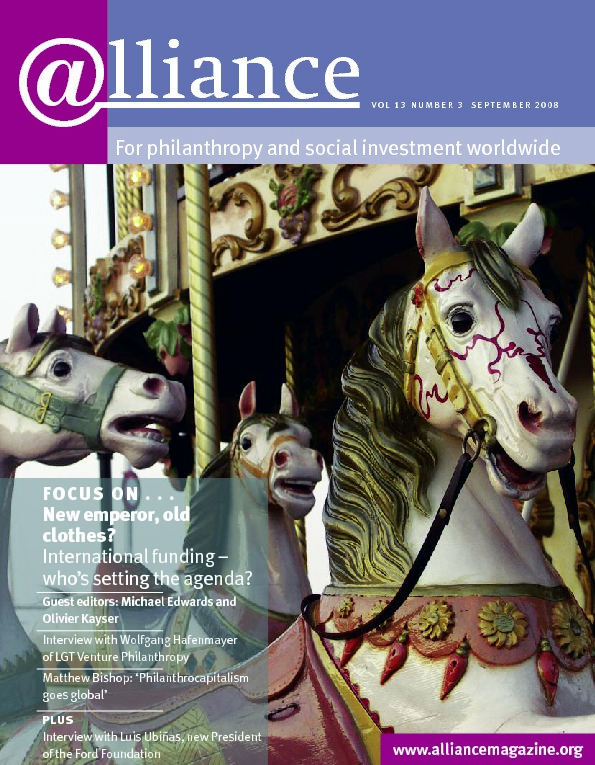 I am often asked to demystify how social network websites can accelerate online donations. I run the Philippine office of AsiaPay, which introduced the first online donation ecommerce service to local NGOs in 2006, and I have enjoyed the mentoring process involved in moving fundraising efforts from face-to-face and mailing channels to the internet.
I am often asked to demystify how social network websites can accelerate online donations. I run the Philippine office of AsiaPay, which introduced the first online donation ecommerce service to local NGOs in 2006, and I have enjoyed the mentoring process involved in moving fundraising efforts from face-to-face and mailing channels to the internet.
Media coverage of the Obama presidential campaign has cast the spotlight on the seemingly boundless potential of fundraising driven by online community building and has raised interest in pursuing similar strategies for philanthropic purposes. This potential seems especially high in developing countries with a young population where new technologies are often well in advance of more traditional means of communication.
The Philippines is an interesting case. Despite a dismal 5 per cent household ownership of computers nationwide, it has achieved a world-leading status as a consumer of internet services involving social networking, video watching, blog reading and photo sharing. A network of cheap internet cafés in virtually every neighbourhood offers the most affordable means of communicating with the Filipino diaspora of approximately 15 million official and unofficial migrants in 194 countries. Filipinos at home and abroad are immersed in the internet not because of their technological prowess but because it is the most economical means to maintain ties with distant loved ones.
Most strikingly, there are approximately 30 million registered Filipino users of social networking services such as Friendster, Multiply and Facebook. If this figure represents unique users, this means that the social networking phenomenon has been taken up by a third of the entire Philippines population in barely five years.
Engaging supporters through the internet
A non-profit considering pursuing fundraising online can be assured that they don’t need to start from zero because of these existing online communities. They do, however, need to discover how they can engage and recreate their community of supporters online.
The internet offers countless tools for a non-profit to exploit for advocacy, so much so that the uninitiated may be bewildered by the myriad technologies and web destinations at their disposal. Social networking websites have evolved since early 2000 to encompass the ability not only to connect people through profiles and basic communication but also to enable users and groups to create and share many types of content. Consider the potential of these, which are already generic in the leading online social networking providers:
- I can write an online post that may receive 1,000 replies.
- I can maintain a blog that may be reposted 10,000 times.
- I can create a photo slideshow that may be shared 100,000 times.
- I can upload a video that may be viewed and embedded in other profiles 1 million times.
The power of new media tools within social networks to share and syndicate instantly may be the most compelling advantage over conventional physical tools of fundraising.
However, the impetus to give online will be triggered only by the skilful and emotional translation of the stories, vision and causes into the new online language. Though the tools in the social web are almost always free, it will require the same discipline of message crafting as traditional donation campaigns to make them evocative and engaging.
Fundraisers who give their thumbs up to social networking will face the obstacle of translating their campaign into credible internet content. The prospect of engaging high-priced new media consultants or, even worse, web developers who speak in the language of code can be barriers to implementation for technology-challenged organizations.
Internet-savvy youth: an untapped source of IT knowledge
I recommend non-profit communities suffering from this dilemma to explore an untapped resource: their youth. Over 50 per cent of the Philippine population is under 21 and this generation leads the way in the adoption of social networking.
Unfortunately, most decision-makers considering the internet did not experience it in their formative years and I suspect would have been content to remain blissfully ignorant about all things online. The good news is that the new generation of every non-profit community is already immersed in the milieu of the online world. They have grown up on the internet and have made social networking part of their relational life. As an initial step towards social networking that generates online advocacy and giving, gather and engage your youth in a series of dialogues that ask the following questions:
- What are you doing online?
- How would you tell our story online?
- What content would you use to dramatize our cause?
- How would you share our message with your friends, your parents and their friends?
- What tools will work best to enable them to spread our cause to their network?
Conducting this simple exercise may reveal surprising insights. Because social networking grows by user-generated content, you may discover that you have the existing human resources to start your online campaign already.
A different approach
Finally, there is a ‘long tail’ in online donation that follows the nature of the internet as a viral tool. According to Wikipedia, the buzzword was first coined by technology author Chris Anderson to describe the niche strategy of internet ventures that sell a large number of unique items, each in relatively small quantities. Success in reaping donations through the internet may not follow the mass marketing models honed in the developed world. It may not be ability to distribute the same letter to 1 million recipients to get a net result but rather the ability to develop a hundred pieces of unique content ready to trigger waves of motivation to give online. Non-profits can readily capitalize on social networks as possessing the built-in tools to deliver their content in this long tail pattern.
Social networking as a community platform levels the playing field. It is no longer a question of having the resources to mount massive campaigns but of being able to transform causes into compelling spokes that keep the giving wheel rolling online. Size and mobilization may not be the factors for online success, but the imagination and commitment to further the conversations incessantly in social networks. Organizations today need not invest in technology since it is immediately available for the price of internet access. Social networks are borderless. As the internet becomes a basic utility even in the developing world, it is becoming the dominant means of relaying emotions and priorities. Non-profit communities who tap into the internet savvy of their youth will jump the learning curve involved in unlocking online donations through social networks.
Andrian Lee is General Manager of eCommerce and ePayment provider AsiaPay for the Philippines & Emerging Markets. Email andrianmail@gmail.com
 Comment Daniel Ben-Horin
Comment Daniel Ben-Horin
Not long ago, I was invited to participate in a conference call organized on behalf of ‘Causes’ – the widget that allows Facebook participants to identify themselves with a Cause, and in turn enables the Cause to access them for fundraising and other organizing purposes.
The ‘rap’ on Causes is that a typical Cause has a million members and has raised roughly $23.85. I was trying to reserve judgement, and thinking about how the access could be developed in a productive way, but the presentation during the call stressed the number of people who will accept an invitation to join a cause, and did not consider the social dynamics involved or the very real resource demands on non-profits if they take up this alleged opportunity. I have a similar reaction to this article.
There’s an expression I like – the ‘drive a cab’ grant. Meaning that in the time it took to get the grant, the applicant could have driven a cab and earned an equivalent amount. Our experience at TechSoup – and keep in mind that we’re in the business of encouraging non-profits to take (appropriate) risks with new tools and also that our staff is heavily tilted (present writer excluded) towards the 35 and under generations – is that allocation of efforts to social networking if fundraising is your true goal will tend to fall into the ‘drive a cab’ category.
Where social networks and fundraising are concerned, non-profits need to carefully distinguish between the exceptions and the rule. An exception is the calamity that transfixes the public consciousness and leads to a seemingly spontaneous combustion of online giving. Or the person who asks everyone she knows to send ten dollars to her cause and emerges at the end with an impressive, if unscaleable, fundraising achievement. But the rule is that the denizens of social networks are primarily young, non-affluent and, most important, incredibly wary of anything that fails the social media ‘smell test’. With rare exceptions, appeals for money do so with flying colours.
The key, I think, is to think about social networks as a means to cultivate communities for varied reasons. Just as non-profits may pursue a ‘drive the cab’ grant for reasons other than the net proceeds of the grant, so can the development of an active social network presence result in relationships that in turn generate real value for your organization. Here, Andrian Lee’s article is extremely instructive. The high level of use of internet cafés, the prevalence of social networking, and the sheer pervasiveness of ‘cell culture’ in the Philippines (and in most of the world, where mobiles have leapfrogged desktop machines as the platform of choice) offer opportunities to engage with constituencies in remarkable ways, as Presidents Estrada and Arroyo can both attest. And out of these new forms of engagement will certainly, if eventually, arise new forms of sustainability.
But if you’re looking for dollars right now, don’t get your hopes up or expend resources better allocated more directly to that goal.
Daniel Ben-Horin is co-CEO of TechSoup Global. Email dbh@techsoupglobal.org





Comments (0)